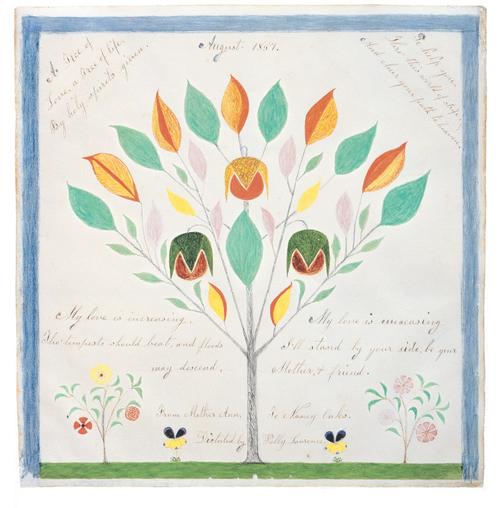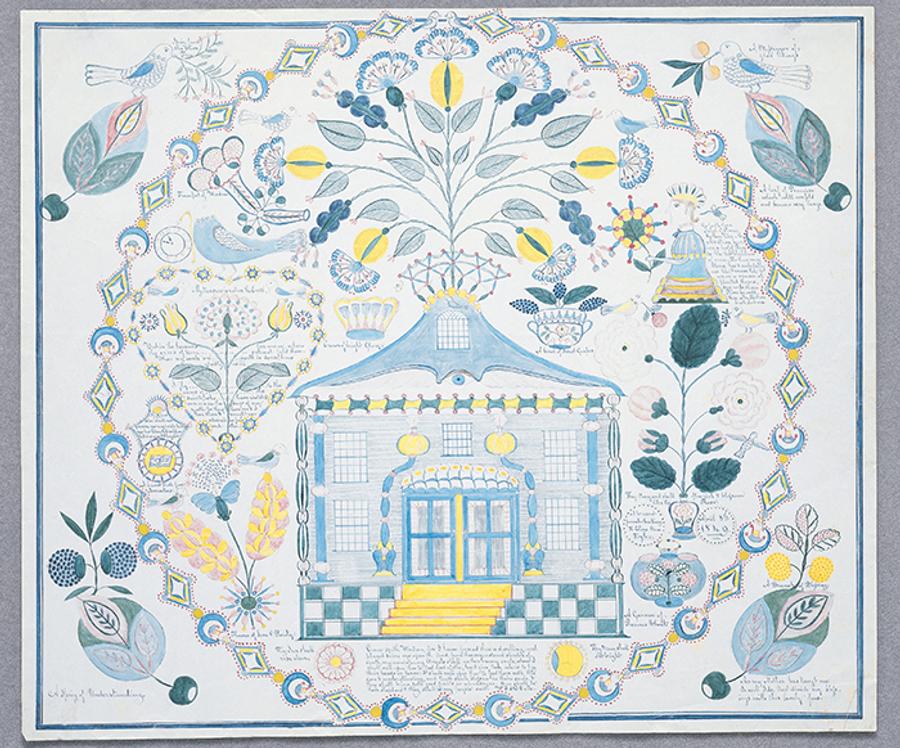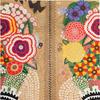Anything but Simple: Shaker Gift Drawings and the Women Who Made Them
- November 30, 2020 17:27


As a part of its 2020/20+ Women @ NBMAA initiative, The New Britain Museum of American Art (NBMAA) in Connecticut is now presenting Anything but Simple: Shaker Gift Drawings and the Women Who Made Them, through January 10, 2021. Organized by Hancock Shaker Village, Pittsfield, MA, Anything but Simple features rare Shaker “gift” or “spirit” drawings created by Shaker women in the mid-1800s, a period known as the Era of Manifestations. During that time, members of Shaker society created dances, songs, and drawings inspired by spiritual revelations or supernatural “gifts.”

Colorful, decorative, and complex, “gift” drawings expressed messages of love, dedication to Shaker belief, and the promise of heaven following the earthly journey. Anything but Simple presents 25 of the 200 gift drawings extant in public and private collections today. This group of drawings, made between 1843 and 1857, is widely considered one of the world’s finest collections and includes the most famous gift drawing in existence: Hannah Cohoon’s 1854 Tree of Life.
The Shaker Soul
The drawings were made by young Shaker women dubbed “instruments” by their elders due to the fact that the women claimed they received these images as gifts from the spirit world. It is perhaps not surprising that a religion founded by a woman should find significant spiritual messages coming from women, even a century before women won the right to vote in the United States. Ann Lee (1736-1784) brought the Shaker faith from England in 1774 with a band of eight loyal followers and was seen to represent the second coming of Christ, giving form to the Shaker belief that Christ’s spirit lives in every person and therefore every person–no matter gender, color or nationality–possesses the potential for a connection with God. This was their basis for racial and gender equality–among other progressive ideals–before the American Revolution.

As early as 1786, when Hancock’s Shaker Village was forming, Shaker women were respected and held as equals in society alongside men–they managed daily chores and did business with the “outside world.” By the 1830s, memories of Mother Ann Lee were fading and new converts needed a way to connect with the late charismatic leader. The Era of Manifestations (1837-1860)–precisely when these colorful drawings were created–was a time of spiritual revival in Shaker villages across America. Certain Shaker women (i.e., instruments) believed they were receiving messages (songs, poems, and drawings) not only
from the spirit of Mother Ann, but from other leaders as well, including Christopher Columbus and Chief Tecumsah.
Mysterious and ornate, the drawings were not shared outside the Shaker community. Worship services, which had previously been open to outsiders, were closed to visitors during the Era of Manifestations. Shakers feared the spiritual messages might scare off potential converts.
The same might be said of the gift drawings–they were kept secret within the community–as outsiders would not be able to understand these gifts. The Shakers’ ban on ornamentation exempted the drawings, because they were never meant to be displayed. They were messages from the spirit world, directed toward a single Believer who would interpret them. Once that Believer died, no one else could translate the message. Most of these beautiful mysterious drawings were eventually disposed of, often used as kindling to start fires.
Extremely rare, the surviving drawings came into the collection at Hancock in a fortuitous manner, facilitated by a woman. Their provenance is undisputed as they passed directly from the Shakers to local collectors Edward and Faith Andrews, who then donated them to Hancock Shaker Village in the 1960s. The Andrews were visiting Sister Alice Smith, who was in charge of divesting the Shaker community of much of its material culture as the group dwindled in size at Hancock. Sister Alice pulled several rolled-up sheets of large paper out of a drawer and showed them the drawings, watching carefully for their reactions. The Andrews were in awe of these depictions of the spirit world, as Alice explained that she had rescued them from a kindling bin near the ovens when she was eight years old. She explained that she was testing the couple, and if they had demonstrated any “levity in their response,” she would have kept them hidden, as it would be clear that the “world’s people”
could not understand these expressions of the Shaker soul. The Andrews recognized immediately how special these drawings were, and agreed to take and preserve them. In total, nine of these drawings have never left Hancock. Others came into the collection through research and acquisition, or were found folded into Shaker-owned books, only recently discovered.

Significant works in the exhibition Hannah Cohoon (1788-1864) came to Hancock in 1817 with her two young children, and lived there until her death. Cohoon painted with a sure hand, using bold color to make a statement and illustrate her message. Her drawings include accounts of her visions, down to the date and time of their receipt. She signs her name, age, and place of creation. Four of Hannah Cohoon’s most significant drawings are included in this exhibition.
Polly Collins (1801-1884) arrived at Hancock in 1820 with her biological family. She was caretaker for the girls during her life, but was most noted as an instrument. Polly kept a journal in which she recorded her dreams and visions. Her most well-known drawing, “An Emblem of the Heavenly Sphere,” includes elements of the traditional women’s craft of needlework, separating the paper into squares and rectangles. Its themes incorporate the natural world, Biblical stories, and Shaker theology, with portraits of Mother Ann, Father James, Father William (Ann’s brother) and Christopher Columbus. Directly under Mother Ann is the Savior, dressed as a Shaker. His hands are raised in a gesture of supplication, but clearly a lesser figure when placed below the Shaker founder.

Sacred Sheets: Two “sacred sheets” will be included in this exhibit. Created at a nearby Shaker village in Mount Lebanon, New York, by Samantha Fairbanks and Mary Wicks, these mysterious forms of gift drawings have been studied more than most. These images offer unrecognizable designs without text, and are often characterized as a purely visual spiritual form of expression, akin to speaking in tongues.
All but three Shaker gift drawings surviving today were created by women. In Shaker communities, where all were seen as equals, women seemed to be more enlightened. They were often the ones reeling and falling down after the ecstatic worship services, having been given the “whirling gift,” as the Shakers called it. Somehow, Mother Ann Lee had cleared the way through her initial prophecy for women in the Shaker faith to become vessels, even more so than men in many ways. Given that God was a dual entity for the Shakers, representing both the masculine and the feminine in one, it’s not surprising that
Shaker brothers had visions as well, and many are preserved in journals, but it was the women who translated their visions into art.
In a community that restricted any decoration until the early 20th century, the gift drawings are an anomaly. However, the Shakers were radical for their time, with an optimistic faith in human betterment and the possibility of obtaining heaven on earth through hard work, integrity, and harmony. It is remarkable to think that such a small group left such a large
legacy of design and spiritual clarity, expressed here in these gift drawings, which depict the spiritual visions that flourished during a time of revival and rejuvenation in the Shaker world.









100x100_c.jpg)






100x100_c.jpg)



